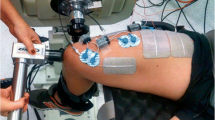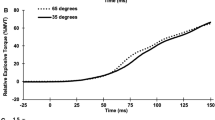Abstract
Purpose
The influence of muscle/tendon vibration on maximal muscle performance is unclear. This study examined the effect of a prolonged tendon vibration stimulus on maximum voluntary contraction (MVC) and explosive voluntary contraction (EVC) performance.
Methods
Eighteen young healthy males (nine strength trained and nine untrained) completed a series of isometric unilateral knee extensions (EVCs, electrically evoked octet responses, MVCs, ramp contractions) pre and post two separate 30-min intervention trials; infrapatellar tendon vibration (80 Hz), and quiet sitting (control). H max and M max were measured at the start and end of each series of contractions, both pre- and post-intervention (i.e., at four time points). Knee extensor force and both quadriceps and hamstrings EMG were measured throughout each series of contractions.
Results
Vibration had no effect on either maximum force (ANOVA, trial × time interaction P = 0.92), explosive force (P ≥ 0.36), or the associated agonist EMG amplitude during these tasks (P ≥ 0.23). Octet responses were also unaffected by vibration (P ≥ 0.39). Conversely, post-intervention H max/M max was 60 % lower in the vibration trial vs. control, and remained 38 % lower at the end of the post-intervention measurements (t test, both P < 0.01). Individual H max/M max depression did not correlate to changes in either maximum or explosive force (Spearman’s Rank, P ≥ 0.54), and training status had no influence on the effect of vibration.
Conclusion
Prolonged infrapatellar tendon vibration depressed H-reflex amplitude, but did not affect either maximal or explosive isometric force production of the quadriceps.






Similar content being viewed by others
Abbreviations
- EMGRMS :
-
Root mean square of electromyography
- EVC:
-
Explosive voluntary contraction
- F 25, 50, 75, 100, 150 :
-
Force at 25, 50, 75, 100 or 150 ms following onset
- HAM:
-
Hamstrings (mean of two EMG recording sites)
- MVC:
-
Maximal voluntary contraction
- MVF:
-
Maximal voluntary force
- QUAD:
-
Quadriceps (mean of six EMG recording sites)
- RFD:
-
Rate of force development
- VMd :
-
Distal vastus medialis EMG recording site
References
Allison GT (2003) Trunk muscle onset detection technique for EMG signals with ECG artefact. J Electromyogr Kinesiol 13:209–216
Bongiovanni L, Hagbartht K, Stjernbergt L (1990) Prolonged muscle vibration reducing motor output in maximal voluntary contractions in man. J Physiol 423:15–26
Buckthorpe M, Hannah R, Pain M, Folland J (2012) Reliability of neuromuscular measurements during explosive isometric contractions, with special reference to electromyography normalization techniques. Muscle Nerve 46:566–576
Crone C, Nielsen J (1989) Methodological implications of the post activation depression of the soleus H-reflex in man. Exp Brain Res 78:28–32
Curtis D, Eccles J (1960) Snaptic action during and after repetitive stimulation. J Physiol 150:374–398
De Ruiter C, Jones D, Sargeant A, de Haan A (1999) Temperature effect on the rates of isometric force development and relaxation in the fresh and fatigued human adductor pollicis muscle. Exp Physiol 84:1137–1150
De Ruiter C, van der Linden R, van der Zijden M et al (2003) Short-term effects of whole-body vibration on maximal voluntary isometric knee extensor force and rate of force rise. Eur J Appl Physiol 88:472–475
Desmedt J, Godaux E (1978) Mechanism of the vibration paradox: excitatory and inhibitory effects of tendon vibration on single soleus muscle motor units in man. J Physiol 285:197–207
Deutekom M, Beltman JG, de Ruiter CJ et al (2000) No acute effects of short-term creatine supplementation on muscle properties and sprint performance. Eur J Appl Physiol 82:223–229
Earles D, Dierking J, Robertson C, Koceja D (2002) Pre-and post-synaptic control of motoneuron excitability in athletes. Med Sci Sport Exerc 34:1766–1772
Ekblom MMN, Thorstensson ALF (2011) Effects of prolonged vibration on H-reflexes, muscle activation, and dynamic strength. Med Sci Sport Exerc 43:1933–1939
Erskine J, Smillie I, Leiper J et al (2007) Neuromuscular and hormonal responses to a single session of whole body vibration exercise in healthy young men. Clin Physiol Funct Imaging 27:242–248
Folland JP, Williams AG (2007) The adaptations to strength training increased strength. Sport Med 37:145–168
Folland J, Wakamatsu T, Fimland M (2008) The influence of maximal isometric activity on twitch and H-reflex potentiation, and quadriceps femoris performance. Eur J Appl Physiol 104:739–748
Folland J, Buckthorpe M, Hannah R (2013) Human capacity for explosive force production: neural and contractile determinants. Scand J Med Sci Sports. doi:10.1111/sms.12131
Hagbarth K, Kunesch E, Wallin EU et al (1986) Gamma loop contributing to maximal voluntary contractions in man. J Physiol 380:575–591
Hannah R, Minshull C, Folland J (2013) Whole-body vibration does not influence knee joint neuromuscular function or proprioception. Scand J Med Sci Sports 23:96–104
Heckman C, Condon S, Hutton R, Enoka R (1984) Can Ib axons be selectively activated by electrical stimuli in human subjects? Exp Neurol 86:576–582
Holtermann A, Roeleveld K, Engstrøm M, Sand T (2007) Enhanced H-reflex with resistance training is related to increased rate of force development. Eur J Appl Physiol 101:301–312
Hultborn H, Illert M, Nielsen J et al (1996) On the mechanism of the post-activation depression of the H-reflex in human subjects. Exp Brain Res 108:450–462
Jackson SW, Turner DL (2003) Prolonged muscle vibration reduces maximal voluntary knee extension performance in both the ipsilateral and the contralateral limb in man. Eur J Appl Physiol 88:380–386
Kameyama O, Hayes K, Wolfe D (1989) Methodological considerations contributing to variability of the quadriceps H-reflex. Am J Phys Med Rehabil 68:277–282
Konishi Y, Kubo J, Fukudome A (2009) Effects of prolonged tendon vibration stimulation on eccentric and concentric maximal torque and EMGs of the knee extensors. J Sport Sci Med 8:548–552
Kouzaki M, Shinohara M, Fukunaga T et al (2000) Decrease in maximal voluntary contraction by tonic vibration applied to a single synergist muscle in humans. J Appl Physiol 89:1420–1424
Kuriki H, de Azevedo F, Negrão Filho R, Alves N (2011) Comparison of different analysis techniques for the determination of muscle onset in individuals with patellofemoral pain syndrome. J Eectromyography Kinesiol 21:982–987
Lapole T, Canon F, Pérot C (2012) Acute postural modulation of the soleus H-reflex after Achilles tendon vibration. Neurosci Lett 523:154–157
Lin C, Chan J, Pierrot-deseilligny E, Burke D (2002) Excitability of human muscle afferents studied using threshold tracking of the H reflex. J Physiol 545:661–669
Macefield V, Gandevia S, Bigland-Ritchie B et al (1993) The firing rates of human motoneurones voluntarily activated in the absence of muscle afferent feedback. J Physiol 471:429–443
Pääsuke M, Ereline J, Gapeyeva H (2001) Knee extension strength and vertical jumping performance in nordic combined athletes. J Sports Med Phys Fitness 41:354–361
Roll J, Vedel J, Ribot E (1989) Alteration of proprioceptive messages induced by tendon vibration in man: a microneurographic study. Exp Brain Res 76:213–222
Sahaly R, Vandewalle H, Driss T, Monod H (2001) Maximal voluntary force and rate of force development in humans: importance of instruction. Eur J Appl Physiol 85:345–350
Shinohara M, Moritz C, Pascoe M, Enoka R (2005) Prolonged muscle vibration increases stretch reflex amplitude, motor unit discharge rate, and force fluctuations in a hand muscle. J Appl Physiol 99:1825–1842
Soda P, Mazzoleni S, Cavallo G et al (2010) Human movement onset detection from isometric force and torque measurements: a supervised pattern recognition approach. Artif Intell Med 50:55–61
Staude G (2001) Precise onset detection of human motor responses using a whitening filter and the log-likelihood-ratio test. IEEE Trans Biomed Eng 48:1292–1305
Tillin N, Jimenez-Reyes P, Pain M, Folland J (2010) Neuromuscular performance of explosive power athletes versus untrained individuals. Med Sci Sport Exerc 42:781–790
Tillin N, Folland J, Pain M (2013a) Identification of contraction onset during explosive contractions. Response to Thompson et al. Consistency of rapid muscle force characteristics: influence of muscle contraction onset detection methodology [J Electromyogr Kinesiol 2012;22(6):893–900]. J Electromyogr Kinesiol 23:991–994
Tillin N, Pain M, Folland J (2013b) Explosive force production during isometric squats correlates with athletic performance in rugby union players. J Sports Sci 31:66–76
Ushiyama J, Masani K, Kouzaki M et al (2005) Difference in after effects following prolonged Achilles tendon vibration on muscle activity during maximal voluntary contraction among plantar flexor synergists. J Appl Physiol 98:1427–1433
Van Boxtel A (1986) Differential effects of low-frequency depression, vibration-induced inhibition, and posttetanic potentiation on H-reflexes and tendon jerks in the human soleus muscle. J Neurophysiol 55:551–568
Conflict of interest
The authors declare that they have no conflict of interest, and that this investigation was conducted according to UK ethical standards for scientific research involving human participants.
Author information
Authors and Affiliations
Corresponding author
Additional information
Communicated by Nicolas Place.
Rights and permissions
About this article
Cite this article
Fry, A., Folland, J.P. Prolonged infrapatellar tendon vibration does not influence quadriceps maximal or explosive isometric force production in man. Eur J Appl Physiol 114, 1757–1766 (2014). https://doi.org/10.1007/s00421-014-2904-z
Received:
Accepted:
Published:
Issue Date:
DOI: https://doi.org/10.1007/s00421-014-2904-z




